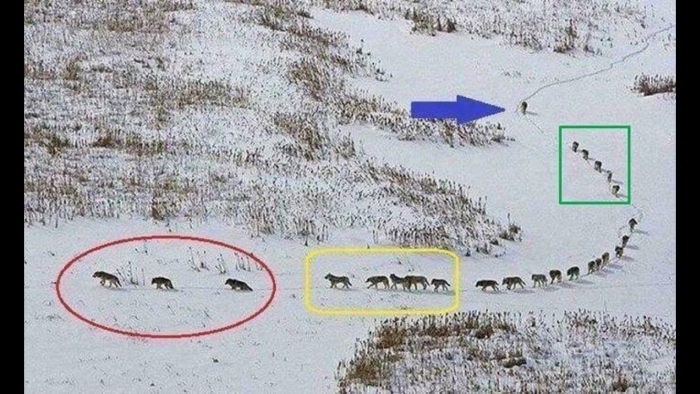Click below icon to Subscribe to Modlingua Channel
-
Hits: 2176
 By Ana Teresa Gaspar
By Ana Teresa Gaspar
The photograph of the wolf pack can be interpreted in a different way, although it became popular due to an inspiring but improbable description. This image became viral on Facebook in December 2015. It was shared along with a vivid description of an inaccurate interpretation of the wolf pack hierarchy. The author claimed that the three wolves in the beginning of the line are the oldest members dictating the pace of the group, while the last wolf, alone, is the leader controlling everything from the rear. Such description possibly misrepresents wolf pack behavior. This story of leadership and management would be wonderful if it were true.
Despite the image’s popularity in the end of 2015, the photo was taken by Chadden Hunter and appeared in BBC documentary Frozen Planet in 2011, as can be seen in the article of the fact-checking website Snopes.com, an online touchstone of rumor research. The original description explained that an “alpha female” (despite some controversy exists about terms like “alpha, beta or omega”), one of the stronger animals, led the pack and, the rest of the wolves followed her through the deep snow to save energy. According to the British daily newspaper The Guardian, the photo caption mentions a pack of 25 wolves hunting bison in Wood Buffalo National Park, on the Arctic Circle in Northern Canada.
The wolf pack is an example of a strictly hierarchical social organization. One wolf alone cannot do much. All the wolves take part in the hunt. Besides, the hunting in groups requires planning. They organize themselves maintaining stability. Communication among the members is the key to caring for their young, defending their territory and bringing down prey. In such sophisticated and rigid group hierarchy, the strong individual who can deal with hard work walks in front. It’s a system of mutual help, not leaving anyone behind. The existence of the pack of wolves aims for survival. This kind of social structure promotes the unity.
Irrespective of the interpretation of the complex wolf pack dynamics, both descriptions present common decisive factors such as organization, communication, and unity. Making an analogy between language professionals and the wolves’ behavior, we can note that we, translators and language professionals must be together and communication is essential to our language professional society. We should not see ourselves as mere language professionals, acting passively in our comfort zones, but as an entity. Today, more than ever, making connections matters. We must interact, collaborate and build relationships. Networking is as important to our success as our language skills are. As the well-known old saying goes, “United we stand, divided we fall”.
Profile Link: http://www.modlingua.com/interns/341-brazilian-portuguese-translator.html
Writer Ana Teresa Gaspar is Brazilian Portuguese and English Language and Translation Intern at Modlingua, India's No1. certified translation and Language service providers based in New Delhi





